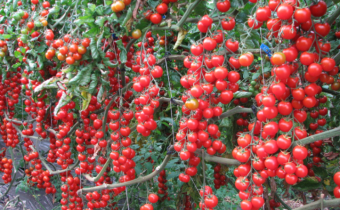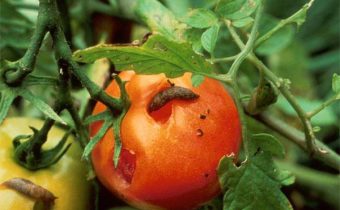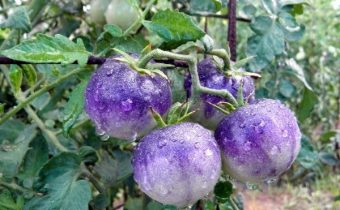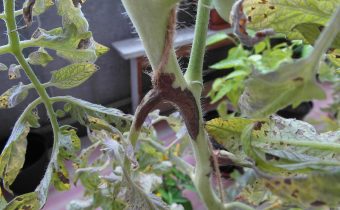Tomatoes eat a caterpillar, what to do
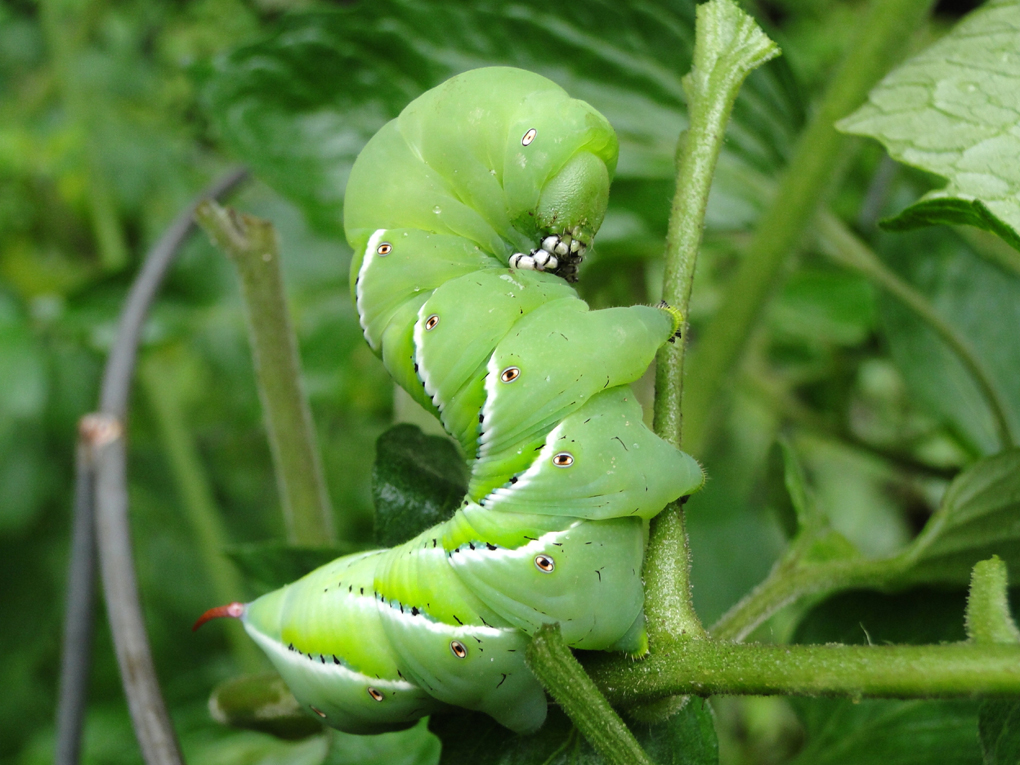
The appearance of caterpillars on tomato seedlings in greenhouse conditions indicates the need for an immediate processing of vegetable crops. Before using this or that method, conduct a detailed inspection. Its purpose is to determine what exactly caused the appearance of pests. As a starting point, there are negative external factors, for example, activation of pests on a nearby plot, or gardener's mistakes associated with improper care.
External manifestations of pest activity
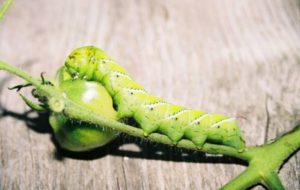
Caterpillars of tomato scoops, reaching a length of more than 20 cm, in most cases, affect landing. The pest has a large and elongated body of green color, on top of which there are 3 strips. They have a light green tint. The peak of parasite activity occurs at the beginning of summer, when butterflies appear from pupae. Their size in adult form ranges from 2.5 to 4.5 cm. The flying insect, which is nocturnal, has a pronounced ornament on the surface of the wings of stripes and figures that resemble the shape of the Latin letter “Z”.
Scoops actively multiply. During season 1, an individual breeds 500 eggs and more on the surface of buds, leaves, and flowers. Identification of masonry can be on the external signs. The egg has a pronounced bulging tip and a flat base. The rate of egg development depends on external conditions. With a stable temperature background and humidity levels, the young will appear within 3-6 days, and under adverse conditions - within 4-10 days.
The young, the development period of which is 18-20 days, first attacks the leaves of tomatoes, and then the buds and flowers. If the gardener leaves the situation without proper attention, then within a few weeks the caterpillars will destroy the fruit. Regular routine inspection of seedlings is the only effective way to notice a pest at an early stage.
Different methods of pest control

Chemical active substances are rightly called the most effective way to destroy caterpillars. Their disadvantages include an increased risk of introducing into the future crop a significant amount of toxic substances, therefore, treatment is carried out in 2 cases - until the beginning of the ovary of the flowers or during a mass invasion of the pest. Before you spray tomatoes with special preparations, you need to look at the calendar. Chemicals are removed from seedlings within 30 days, so no need to deal with the processing of the crop on the eve of its collection. When choosing insecticides, preference is given to those substances that equally affect the caterpillars and butterflies, otherwise the treatment will not be sufficiently effective.
Preparations
| A drug | Mechanism of action |
| "Inta-Vir" | For every 10 liters of water take 1 tablet. Spraying is carried out 2 times per season. |
| "Decis" | For every 5 liters of water take 100 g of the emulsion concentrate. Provides protection of tomatoes for only 15 days, after which they are re-processed. |
| Avant | The solution is applied to the treated surface only in dry and frying weather. It is used 1 time per season, otherwise there will be an increased level of chemical concentration in tomatoes. |
More common are drugs of hazard class IV, called biologically active substances. Their components are derived from tomatoes within 2-3 days. The list of such drugs is as follows:
| A drug | Mechanism of action |
| "Actofit" | In a 5-liter bucket add water and 1/3 of the required volume of the drug. Once the solution has become homogeneous, make up the remaining volume of water. The recommended concentration is 5 ml of solution for every 1 liter of water. Spend 2 treatments during the season. |
| "Fitoverm" | For every 10 liters of water take 1 ampoule. Processing is carried out 2 times per season. |
| "Lepidocil" | For every 10 liters of water take 20 ml of the drug. Processing is carried out before the start of the ovary of flowers. |
Every year it is recommended to use various chemicals and biologically active substances, otherwise the pest forms a strong immunity.
Folk methods of struggle
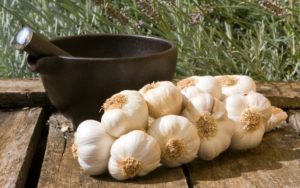
We need to resort to them, the sooner the better. In the case where there is a massive destruction of planting tomatoes, popular recommendations are useless. The first recipe is as follows:
- 2 heads of garlic;
- 2 bunches of medium sized garlic arrows;
- 1 can with a capacity of 1 l;
- put the ingredients in a container and fill with water;
- 72 hours to insist;
- strain;
- ½ cup put in 1 bucket of water;
- add ½ bar of laundry soap, which is pre-crushed.
Processing is carried out 2 times per season. The second popular way of dealing with caterpillars includes the following ingredients:
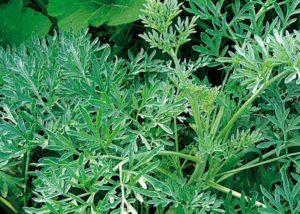
- 1 bucket;
- fill it with 1/3 of fresh wormwood;
- pour cold water;
- bring to a boil over low heat for 30 minutes;
- 48 hours to insist;
- strain;
- dilute with fresh water at a ratio of 1:10
- add ½ bar of laundry soap, which is pre-crushed.
Completes the list of folk recipes mixture of boiling water and tobacco dust. To prepare the mixture requires 300 g of product and 2 liters of hot water. The solution is infused with the lid closed for 24 hours. The next step is to add ½ part of the shredded bar of laundry soap. The mixture is brought to a homogeneous state. Processing is done 2 times per season. In the case when it comes to the average degree of pest damage, the following recommendations will come to the rescue:
| Substance | Action description |
| Cold water | This technique is used only in the early morning until the surface of the leaf is not heated by the sun. Otherwise, the gardener's actions will trigger shock. Water is supplied under a slight pressure. With it, you can wash the larvae and caterpillars from the surface of the leaf and stem. |
| Lather | If we are talking about a small greenhouse, then green or laundry soap will come to the rescue. It is enough to beat it into a resistant foam, which is then carefully applied from the outside and inside of the sheet. |
| Saline solution | 1 package of table salt is diluted in 10 liters of water. Spraying is carried out 1 time every 5 weeks. Under the influence of salt caterpillars perish. The disadvantages of the described methods include 2 factors. The first - in case of exceeding the specified dosage increases the risk of damage to the fruit. The second is that salt has almost no effect on butterflies. |
| Garlic arrows | Take 1 kg of dry product and pour it 2.5 liters of boiling water. The mixture is infused with the lid closed for 14 days. As soon as the solution is fermented, it is filtered. The resulting liquid is diluted with cold water in a ratio of 1:10. Total spraying is allowed only in dry weather. |
| Potato tops | To prepare the tincture required 1,5kg tops, which is filled with water in the ratio of 1:10. Over the next 24 hours, the mixture is infused and filtered. In the resulting solution add ½ bar of soap. Spraying is carried out every 5 weeks only in warm and dry weather. With a high level of moisture, potato tops lose their effectiveness. |
These methods are effective only when the pest is in the form of larvae. As soon as the parasite turns into butterflies, unfortunately, folk methods should be abandoned in favor of more effective means.
Preventive actions
A common form of tomato contamination in a greenhouse is the flow of a butterfly through an open window. On the one hand, regular airing ensures the full development of the tomato, and, on the other hand, it is necessary to constantly monitor that the pest does not get into the room. Reduce the likelihood of such a development will help the grid with small cells, through which pests do not penetrate. Continue the list of preventive measures listed below tips:
- constantly remove weeds;
- prevent the accumulation of rotten fruit and fallen leaves on the beds;
- before planting, the soil is treated using a solution of potassium permanganate (concentration 2: 1), destroying even those pests that survived the cold;
- at least once every 3 weeks, spray the seedlings with “Citcor” or “Decis” to enhance immunity;
- Do not use chemicals after the start of fruit set;
- the easiest way to destroy the young, rather than adults;
- after harvest, all plant residues are harvested and burned, otherwise the reappearance of the pest will not take long.
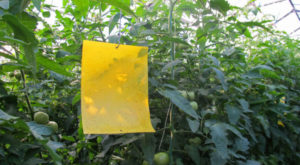
In the summer, they regularly loosen the beds, thereby destroying the laying. For prophylactic purposes, twigs should be arranged at 5-7 points inside the greenhouse. They are attached to pieces of yellow paper, soaked in honey or vaseline. Scientists have proven that the pest actively seek such a trap. Update it every 6 days. The list of helpful prevention tips continues with the recommendations below:
| Plant | Nature of impact |
| Celery or coriander | Planted between rows of tomatoes. The smell of culture is so unpleasant for butterflies and caterpillars that they cannot physically get close to seedlings. |
| Celandine | It is mixed with 100 g of wormwood, 500 g of tobacco, 50 g of tobacco and 250 g of garlic feathers. All pour 11 liters of boiling water, insist 30 hours. Filter the mixture and add ½ bar of soap. The resulting solution is used for spraying seedlings at least 1 time every 6 weeks. |
| White mustard | It is planted in early spring, after it germinates a little. The closer it is to the tomatoes, the less chance the caterpillars. Another option for its use - the creation of a solution. For every 1 liter of water take 100 g of dry matter. The resulting solution is sprayed with plants once every 5 weeks. |
The listed recommendations are effective only if they are used together with traditional prophylactic agents.
The problem is easier to prevent than to try to eliminate its consequences. Before planting tomatoes in prepared wells, they are pretreated with Prestige. You can buy it in the syringe dispenser.
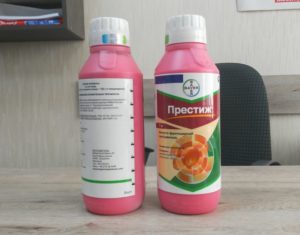
For every 100 ml of the drug take 50 ml of water. In the resulting solution is placed seed for 25-30 minutes. As soon as the specified time interval is completed, the future tomatoes are sent to the prepared wells. In most cases, a one-time treatment is enough to reduce the likelihood of a scoop and Colorado potato beetle throughout the season.
The activity of the caterpillars is noted with the onset of stable hot and dry weather. Pests leave the dungeons where they spent the winter. Within a few days, they form pupae on the inside of the leaf, from which butterflies emerge. The latter lay several hundred eggs per season, after which they die. A gardener who conducts a regular inspection of crops will immediately notice that something is wrong. At the initial stage, folk methods and biologically active substances are effective. As soon as the problem turned into an acute form, butterflies appeared, a metered use of insecticides was required.


